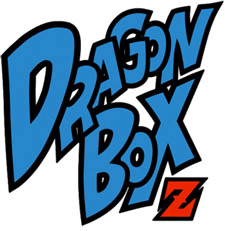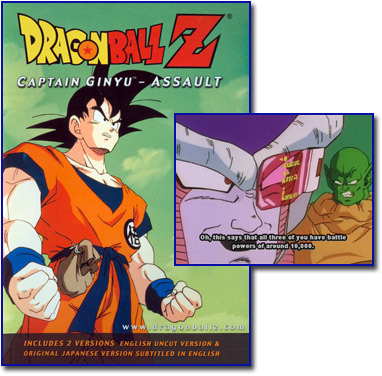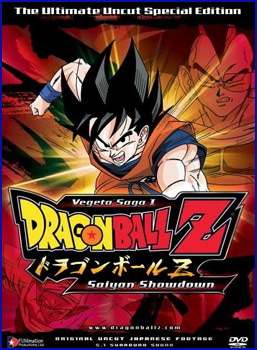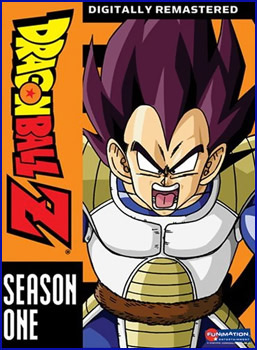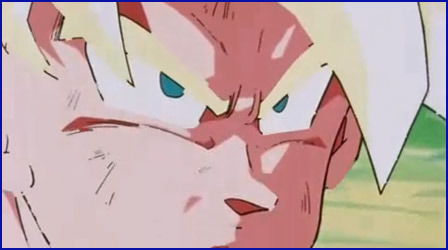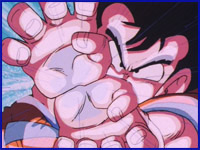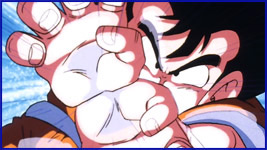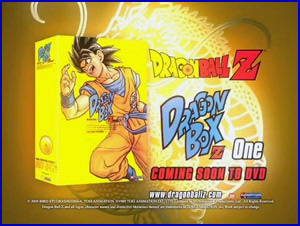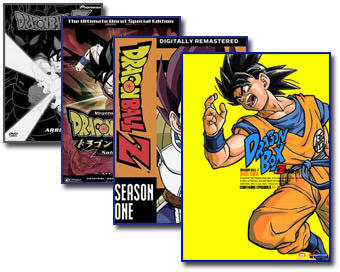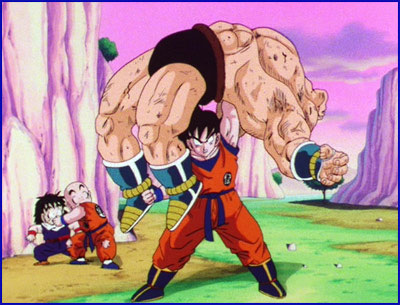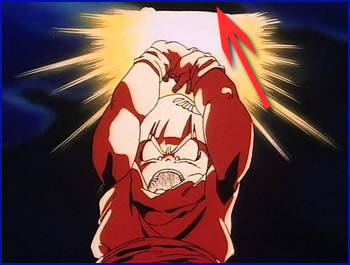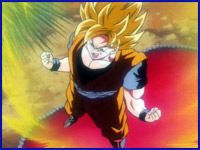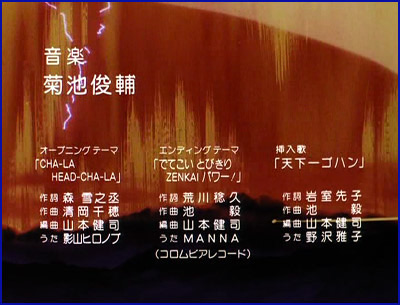|
|
|||||||||||
| Pojo's Dragon Ball Z news, tips, strategies and more! | |||||||||||
|
|
|||||||||||
 |
|||||||||||
|
|
|||||||||||

Main
Magic |
Pojo's Dragon
Ball Z News
INTRODUCTION FUNimation is re-releasing the DragonBall Z TV series for what seems like the billionth time (for those actually counting, some of these episodes are on their fourth official release). Why is there celebrating in the streets? Why is this particular release such a big deal? Why are these "older" and "hardcore" fans of the Japanese version suddenly coming out of the woodwork with enthusiasm, and especially for a company that has typically ignored or worked-around the pleas of this one, single, vocal-minority sub-set of fans for the last fifteen years? It's a big deal. Really. Let me explain. North American fans of the DragonBall franchise existed long before FUNimation existed as a company. There was already an entire generation of fansites on the web, already the majority of the series fansubbed on VHS, and already newsgroups brimming with discussions about so-and-so's power level long before FUNimation entered the picture. It's funny to look back20on the availability of the series to fans before FUNimation came around — the hit-or-miss video/audio quality on VHS tapes, gross translation inaccuracies, and a disgusting inconsistency among what you would find for episodes (and movies) actually there to obtain. Sound familiar? Poor DVD encodes, rewritten dialogue, releases out-of-order... fans have been craving a way to properly see the series even just in chronological order, nevermind any other aspect, since it began! Remember that DragonBall Z was just finishing on Japanese television when FUNimation obtained the rights to the series in the first place, and even when they did bring the series over, regardless of fond memories one may have of the televised dub, it was censored, dub-only, and had no uncensored equivalent beyond shoddy fansub VHS releases. It's hard to imagine this kind of era for today's fans that have immediate access to high-definition, subtitled releases that magically appear on their hard-drives for free (if they even have to download anything). FUNimation's "Dragon Box" sets are not for these types of fans. Are we talking about you with that statement? Perhaps; it's tough to get a firm grasp on what the general audience of Daizenshuu EX truly is, these days. Even if you are a younger, confused, FUNimation-dub-only type of fan that just shelled out for nine season box sets, you should at least be aware of what these products are and why you should (or should not?) care.
THE BACKGROUND HISTORY FUNimation's home releases have always been a mixed-bag for fans of the Japanese version. While we initially had censored, dub-only VHS/DVD releases of the original broadcast run from 1995-1998 (that includes the first season of DragonBall and the first two seasons of DragonBall Z), 1999 brought us "uncut" VHS releases of the third season of DragonBall Z. The problem was... it was an entirely new (and extremely amateur-at-the-time) voice cast, the music was not what had been used in the dub for several years prior, nevermind the original Japanese score... and it was dub-only. Despite FUNimation CEO Gen Fukunaga promising (and even personally anticipating with delight!) a dubbed release with the original Japanese music, it was a product that would come far-too-little, far-too-late, and on the third DVD release of the DBZ TV series in 2007... over a decade after FUNimation's original promise. It was the first example of the company seemingly lying to their hardcore fanbase with the disposable income ( presumably being "older" if they were fans of the Japanese version) to actually fund the products. Would it prove to be a successful and "correct" business decision? With the DragonBall franchise rocking the domestic anime industry to this day as one of the few products that actually sells on store shelves... possibly so. But did that make it right...? In the eyes of many fans, the answer was a resounding "no". The announcement of dual-language DVDs with subtitle translations by long-time-fan Steven J. Simmons for 2000 was one of the few standing-ovation moments we've had over the years. Not only were we getting the original Japanese version of the series, but it was coming out on a format that would not break down in our players, and was translated by someone not only with the language chops, but also extensive fandom knowledge (check out Episode 52 of our podcast for an interview with Simmons).
It would be easy to compare this original announcement and release of subtitled DVDs to the most recent announcement of "Dragon Box" sets, at least on an emotional scale to the hardcore fans. It certainly resonated at retail; many online dealer s such as RightStuf were temporarily out-of-stock due to the massive demand for these first two Captain Ginyu volumes. Even with the initial problems of minor dialogue censoring and dub-spellings in the Japanese translation track ("Krillin", "Frieza", etc.)... we were watching DBZ in Japanese. Legally. On DVD. Despite those minor pitfalls, without FUNimation using the word, we felt like we had the "definitive" release. Even Japanese fans did not have a home release of the series! Sure enough, that would normally be enough to satisfy a fanbase. DragonBall fans are an interesting bunch, though. Whether or not you empathize with or roll your eyes at them, there were a varying level of both legitimate and asinine qualms with FUNimation's continued release of the series that fans brought to light. Things like poor video compression, low episode counts, missing credits, releases out of order, budget-looking cover art... these were the norm of the time. Even with these complaints, for one of the only times in North American DragonBall fandom history... things were calm for a while. FUNimation continued on with their single-disc releases from October 2000 to November 2005. Their dub continued to air on Cartoon Network and make its way to home VHS and DVD, with Japanese fans always having that unedited, bilingual DVD as an option. But just before the end20of the DragonBall Z single-disc releases, and just before heading into a home release for DragonBall GT... FUNimation threw one of their first curve-balls. Even though FUNimation announced in 2003 that it had secured the home distribution rights to the first two "seasons" of DragonBall Z and would be going back to re-release these episodes uncut on DVD, this otherwise-happy moment was really the turning point for fans of both the Japanese and FUNimation-reversioned DragonBall Z to become at worst betrayed, and at best horribly confused.
A new dub of the first two "seasons" aired on Cartoon Network. While many fans of the original Japanese version had moved on from caring about this re-dub, at least a few of them (and many of the dub fans, themselves) were hopeful, even cautiously optimistic, that FUNimation would take the opportunity with a "re-do" to crank out a more faithful script, better performances, etc. Unfortunately, a good portion of the dub script was taken verbatim from the original 1996-1998 syndication airing (horrible jokes and all). Sadly, it seemed to be the final nail in the coffin for any hope whatsoever for a faithful English dub of the DragonBall Z TV20series. The dub itself was hardly the worst of it, though. At least that could be looked over if you were a fan of the Japanese version, anyway. While this new dub aired in its entirety on Cartoon Network, the so-called "Ultimate Uncut Edition" never saw a full release on DVD. After nine volumes (which included two collector's boxes), FUNimation silently canceled this series of releases. Fans potentially had a box they would never fill, and approximately 40 episodes completely unavailable "uncut", regardless of the language/voice-cast choice. It was impossible for North American fans, a decade after the licensor first brought the series over, to own the entire series on any home format.
THE SEASON SETS No-one asked for it. Not like this.
Regardless of your technical knowledge and/or ignorance, we can all admit that none of us saw it coming, and none of us really needed or wanted the fanbase even further divided. It was tough enough for there to20still be "dub" and "sub" arguments, and now those two opposing factions would themselves be split over the video presentation, rather than the content itself there-in. FUNimation began releasing box sets in a "season" format in 2007. These so-called "orange bricks" were touted as a complete remastering of the series... which sounded good... in theory. It turned out that the "remastering" was little more than an automatic process with heavy digital video noise reduction (spearheaded by an individual with little experience in much more than video adjustments on pornographic works) which at times removed so much detail that character outlines were flat-out destroyed, particularly in scenes with heavy movement such as shaking.
It was also cropped into a widescreen presentation, and despite all explanations about restoring footage from the left- and right-sides that had never been seen before... despite all delusional claims about overscan somehow affecting the presentation... approximately 20% of the actual footage from the top and bottom of the video was removed. Yes, there are plenty of times when you can find yourself "lost in the show" and temporarily=2 0ignore the video faults. For those with so many years of history with the series, though (the ones who can quote dialogue in Japanese and remember pixel-perfect framing of scenes)... it can range anywhere between slightly-bothersome to downright-maddening. Of particular note was the near-insulting and deceptive original trailer for the faux-"remastered" sets: Let's break down its claims section-by-section (acknowledging that these comparisons and complaints are now irrelevant due to domestic "Dragon Box" release announcements, but presented as a historical record of how fandom has been treated): DragonBall Z has been digitally remastered and will be presented in a brand-new 16:9 format with a 5.1 surround audio mix, completely uncut and in its entirety. These new releases represent the ultimate and definitive editions of DragonBall Z. The words "ultimate" and "definitive" were not used for the first time, and will not be used for the last time with the faux-"remastered" season sets. It becomes increasingly difficult for even the most casual of fans to take these claims seriously when they are reiterated with each subsequent20release. Just how many "definitive" box sets can there be...? The newly remastered DragonBall Z footage has been transferred from the original Japanese film prints which have been carefully stored in FUNimation's film vault. These film masters have gone through a very extensive clean-up and transfer process and have been captured digitally in high-definition. The digital clean-up of the film was performed frame-by-frame and has allowed every last second of DragonBall Z to be returned to its original pristine visual condition. It was indeed true that FUNimation used "original Japanese film prints", but the deception here is that they were nowhere near the type of original 16mm film prints actually taken out of cold-storage by Toei and Pony Canyon for the "Dragon Box" remastering process (be sure to read below). Furthermore, later comments and analysis (including back-and-forth communication with Steve Franko of Studio Post & Transfer, the company responsible for the "remastering") brought out the reveal that the remastering was not "performed" frame-by-frame, but rather went through a semi-automatic process that was only occasionally spot-checked for general clarity and performance. The new transfers have been performed at 16:9 allowing more imagery to be view ed in the horizontal frame than was previously allowed by the standard definition transfers. This new 16:9 aspect ratio also presents the viewer with a more cinematic viewing experience. The colors have also been left completely unaltered; no adjustments to the brightness, contrast, or saturation have been made, which allows for the film to be presented as originally intended. And later... Take a look at some of these shots of the footage before and after the remastering process. Notice the extended imagery in the horizontal frame. Also notice the more subdued and natural colors. Again, these are the original colors of the Japanese film prints. These statements are a combination of standard misleading statements and pure fabrication. It is true that the process of scanning in the film allowed for slightly more (~5%) viewing area in the horizontal frame to be acquired. At the same time, the process of actually cropping the top and bottom to get to that 16:9 aspect ratio removed approximately 20% of the total visible area, in a show that was never framed or intended to be viewed that way. Additionally, claims that the colors were "left completely unaltered" were flat-out false; compare the following "Dragon Box" and FUNimation "remastered" shots for yourself:
Note the loss of detail in Goku's Kamehameha shot. While not incredibly significant, shadows approach disappearance and some speed lines are entirely removed. Both shots showcase the extent to which the contrast and saturation were played with, entirely contrary to FUNimation's claims about leaving it alone. While many fans will point to scenes like the SSJ Goku loss-of-detail due to shaking from earlier in the article as primary examples of what was wrong with the remastering, these two comparison shots are the "everyday" examples of detail loss and color adjustments that went into the sets. The "subdued" colors FUNimation speaks of are nowhere to be seen; anything with a flash or larger-than-normal amount of white is completely washed out and near-blinding. The newly remastered footage has also been transferred f rom the film at 24 frames per second, the original frame rate of the film. This is important to note, as it allows the film to be captured digitally, frame by frame, and does not add visual data that could interfere with the image quality. This was possibly the single instance of completely accurate and non-misleading information presented in the trailer. The remastering from film was performed at 1080p, which is the highest-quality HD format commercially available today. This is an exciting new era for DragonBall Z, and we at FUNimation hope that the millions of DragonBall Z fans around the world will go back and experience the quality that DragonBall Z is known for in its originally intended, unaltered state. FUNimation made a big deal out of the fact that these new prints were scanned in high-definition, yet would release only the movies on Blu-ray. Fans naturally assumed (as FUNimation most likely did, themselves) that a Blu-ray release of the regular TV series would follow after a complete standard DVD release, so while no benefits from the high-definition scan would be gained from a DVD release, the entire process would at least be somewhat future-proof for FUNimation in allowing them to put out a subsequent release from the same new "masters". In a later trailer included on the first box set, a quick video clip is s hown comparing "before" the digital video noise reduction and "after". Careful analysis by us here at Daizenshuu EX along with some of our peers in the video profession led us to believe that the grain present on the image is a complete fabrication, and was added to an already-DVNRed clip. While not a particularly major deception in comparison to some of the other claims, it was just one more for the pile.
Ignoring all of the flaws with the product, the biggest problem fans had with the release was the giant lie that it was. Fans were told that this was the "definitive" version, and yet its entire existence was based on a series of lies. Those drinking the Kool-Aid became impossible to argue against, no matter the logic and concrete examples brought to the table. Fans essentially had to suck-it-up and purchase these sets if they ever wanted to own an uncut version of the show, let-alone a consistent one. FUNimation made it apparent... this was it. You want the series? Here's how you're getting it from now on. This would be the first and only consistent release of the DragonBall Z TV series there had ever been in North America. It was a release that further split an already-hea vily-divided fanbase, brought a dub-with-JP-music to an audience that no longer cared about its existence ever happening... ... and yet sold like hot-cakes. Despite heavy criticism from well-known fandom outlets like Anime on DVD (website) and Anime World Order (podcast), jabs from peer domestic anime companies like ADV, and even their sub-licensor Madman from Australia stating they would rather have the series in 4:3... the season sets would go on to be incredible-sellers in the industry, with the first season being the best-selling anime in 2007... despite being out for only three months of the fiscal year. FUNimation was at the forefront of restructuring how the entire domestic anime industry was working, and the DBZ season sets were a prime example of this innovation and dedication. A reduced price point for a large number of episodes was what needed to happen. The sad thing was that those sticking to their guns and who refused to support the series in this incarnation were probably the worst off; by holding up their pride and refusing to allow themselves to just go on and complete their collections, they were denying themselves the a bility to finally see the first two seasons subtitled on DVD. It was yet another case of fans holding out for a hero... one that may never come.
FUNIMATION'S FOURTH RELEASE Why another release? Why now? Many of us assumed, after FUNimation made clear the effort that went into their own remastering process, that these new "masters" would be what the North American market would be stuck with for the foreseeable future. FUNimation made it a point to note that the series was remastered in high definition, and it seemed logical to us that once the standard DVD release finished, the next in line would be a re-release of the same product on Blu-ray. FUNimation always keeps a fresh DragonBall Z product on store shelves, so in addition to the logic behind getting as much mileage out of their new masters as they could, it made sound business sense; DBZ sells, so keep putting out DBZ.
Holy black on a Popo! FUNimation announced in July 2009 at their industry panel at the anime convention Otakon their licensing and forthcoming release of "Dragon Box" sets based on the genuinely-remastered release of the same name from Japan several years prior. The release would begin in November 2009 and span across seven sets. Clearly aimed at "hardcore" fans (and specifically those of the original Japanese version of the show), the packaging would closely mirror the Japanese packaging, would include an 80-page hardcover book with each box, and even default to the original Japanese language track. This set would be the fourth official release of some earlier episodes of the DBZ TV series in North America, would be the second "consistent" release of the entire series, and for many fans, is set to be the definitive release, finally coming to them a full fifteen years after FUNimation first acquired the license to the franchise.
WHY WE CARE It is a fair question to ask why we should suddenly be excited. This is at least the third release of the DBZ TV series (fourth in a few episodes' cases). FUNimation has ignored many prior complaints with regards to their treatment of the series. They have canceled releases mid-run (DragonBall on VHS [which was slightly more understandable] and the "Ulti mate Uncut Edition"), and have just announced another release of the entire series a mere two months after the release of the "final" box set from their own "remastered" release.
Why are the obligatory screen-shots of Gotenks holding up his middle finger not flying around? Why are there instead forum posts of nothing but fireworks and pigs flying? Why are we so excited? In case it has not been made clear already, fans of the Japanese version of DragonBall have almost always been given the shaft by FUNimation. Beyond possibly the release of dual-language DVDs at all, there have been few instances where this fanbase has been even so much as acknowledged, let alone catered to. All advertisements and packaging for the series reflect the over-the-top WWF (OK, so now it's WWE, right...?) mentality that FUNimation went into with "season three". Snarky jabs toward old fansubs led into new opening themes of ridiculous, over-the-top rap music, with the whimsical and adventurous qualities many of us see in the series and identify with it are all but washed away. Also entirely gone from FUNimation's production was any hint of the spiritual and "old-school martial art s movie" charm; while references to deities and ki remain in some context, the amount simply pushed aside removes an undeniably large amount of the supporting emotion in the series. When hints of Japanese were used, it was carelessly inserted as complete gibberish in a failed attempt to appeal to both sides, all the while telling us it was "the voices we love" and "the way it was meant to be seen" (or, rather, "yanena rachiru noya rachimo henachihoya yama tsuna monanaho"). No matter how proud you are of your fandom and how self-confident you are, there have been times where fans of the Japanese version couldn't help but feel embarrassed to be a fan, thanks exclusively to FUNimation and their "reversioned" production.
It all makes sense, though; FUNimation and their dub (and from their viewpoint, at least, its altered tone and focus) brought the series to exponential new heights in North America, to the point where long after it has been removed from regular TV rotation, its video games can sell enough like hotcakes to warrant legal action to maximize profits among all companies involved. Was it really their treatment of the franchise that brought it to these heights, though? Long before FUNimation even existed as a company, the DragonBall franchise was running strong in countless other territories throughout the world. One needs look no further than areas like Spain, Italy, and the entirety of South America for examples of the series being treated with accurate-respect and still hitting the heights of popularity. Of special note would be the Mexican dub, long held by international fans as one of the prime examples of proper and respectful dubbing; Shunsuke Kikuchi's original score is kept, dialogue is near dead-on accurate to the original Japanese script, and voices are astonishingly-close to their original performances when needed. Fans of the original Japanese version will claim that the show would have been successful anyway, and that all of FUNimation's changes or "reversionings" were an exercise in pointlessness. It wasn't just the tone of the dub and its marketing that were an annoyance; it was that this company felt they had to tamper with the show in the first place at all, which in turn affected now-two-sides ("dubbies" and "subbies", if you will) and tossed more fire on the flames of such a legendary, if not disgustingly cliché, conflict. Especially post-"Season Three" with the loss of Saban as a syndication distributor and going it on their own, FUNimation had the opportunity to simply release the show and let it take off on its own (as it no doubt would), rather than release such a gross alteration of it. These same fans (though the same could be said about the die-hard FUNimation dub fans) can easily be classified as whiny, arrogant, delusional pricks with a sense of entitlement the size of California, so why go out of your way to cater to them? On the other hand, such "hardcore" fans have experiences, knowledge, and a smile-filled dedication and deep love that few other fanbases have. Clearly this is a statement that we matter. Not only does this new, domestic "Dragon Box" release default to the Japanese language track... not only does it come packaged in a style closely mirroring its original Japanese counterpart... but it is also affordable. While we would never expect a domestic release these days to come anywhere close to the cost of a Japanese DVD release, this type of styled release could easily fetch and demand at least a slightly higher price tag. With a promised 42-episodes at $80 MSRP, the cost-per-episode ratio is not outlandishly-higher than FUNimation's own faux-"remastered" season sets. We matter enough that they not only listened to what product we wanted, but are releasing it in a way that isn't complete highway robbery. That alone demands some sort of respect and applause. We received subtle hints of this over the years if one really stops to think about it. The entire background score for the first DragonBall TV series was kept as-is, along with dubbed versions of the theme songs. For the "season set" treatment of DragonBall GT, the much-criticized "Step Into The Grand Tour" rap song was completely abandoned in favor of newly-dubbed theme songs, and while the original broadcast dub track was still included, a dub with the Japanese score (a la the DBZ season sets) was included as an additional audio track.
As of this writing it is still early in the game, so while our excitement is warranted (and damn does it feel good to finally be this excited about a domestic release!), we may also want to err on the side of caution. While it would be crazy to think that FUNimation does anything intentionally with malice, we have had more than enough disappointments in the past to jade us. Will the episode count be adjusted to take the additional audio tracks into consideration? Will any of the "extras" be brought over in the boxes? Why should we bother with the new (original) DragonBall release of FUNimation's own-remastering if there is a possibility of a "Dragon Box" release later on? FUNimation is in a sticky-situation by potentially alienating groups of fans yet again. While it is easy for us to sit back and bask in the glory that is a "Dragon Box" release that defaults to the original Japanese language track, there will be a dub included. However... which dub will or should this be? While foreign dubs (even English ones like the "alternate" dub done via the AB Groupe and the Ocean Studios cast primarily for the British market) will almost certainly not be included, ever since their "season set" releases, FUNimation now has two of their own competing dubs of the DBZ TV series. The "first" was the version broadcast on Cartoon Network with their own voice cast and re-d one musical score (outsourced for seasons three onwards, and brought back internally for the re-dub of the first two seasons). This has been the "default" language track and promoted version of the show from FUNimation since the beginning of their own individual DVD releases. This was complemented by the inclusion of a second dub track on the "season sets" which contained a slightly-updated version of the original dub (with some voice actors returning to either do re-takes on certain lines, or replace inconsistencies in voices due to actors being replaced over the years) as well as the original Japanese musical score. Note that this is the same original Japanese score that, for the most part, we assume to have an audience that merely spot-checks it out of morbid curiosity. One would assume that at this point in time, you are either a fan of FUNimation's broadcast dub, or you are a fan of the original Japanese version; the "dub-with-Japanese-music" track seems to exist as nothing more than a curiosity. Is there truly a substantial audience at all for a dub with the Japanese score, anymore...? Hopefully you can understand our concern and frustration. Every DBZ home release has been promised as "ultimate" or "definitive" in some way, and always has some major aspect or repercussion that prevents it from being so. With a "Dragon Box" release we are finally so close... and20we can't help but contain our excitement with hesitancy. After all, the first communication we received about FUNimation's "Dragon Box" release was a Chris Sabat "Vegeta" in-character, screaming, internet-meme-filled rant about the qualities of the set. Is this the image we should expect from it...? While it is absolutely one of the most exciting products to come to us in the history of our fandom, and the in-character Vegeta certainly gets at least that excitement across, its tone just feels... wrong. It's easy to sit back and criticize it now, especially after the first viewing at the Otakon panel was met with such a resounding applause. In all honesty, though, take a look back at the tone, presentation, and maturity of the faux-"remastered" sets trailer. Everything was to-the-point, backed up with examples (as flawed as they were), and authoritatively-excited... without resorting to a played-out "lolz 9000". We personally hope that whatever further advertising the FUNimation "Dragon Box" sets receive will be more like that type of trailer; it's what it should have received in the first place. It's hard for us to contain our child-like exc itement, though. In an era where classics such as the original Super Dimension Fortress Macross, Tekkaman Blade, GoLion, and others are all receiving their own accurate and complete releases, it is a sigh of relief and vindication to see DragonBall finally receive the same.
"Dragon Box" vs "Season Set" comparisons went out-of-style back in 2007, so we will not dwell on them too much. Putting all opinions aside, based on what the show actually is (a cartoon from 1989-1996) and what can be done to video footage with today's technology, the Japanese Dragon Box releases truly are the quintessential release of the series and a prime example of balancing monetary gain as a profitable company with genuinely caring for the series on an artistic and historical level. Beginning in 2003, Toei (in conjunction with Pony Canyon) began releasing the entirety of the DragonBall franchise on DVD in what they called "Dragon Box" sets. These were limited-edition boxes that could only be purchased via a pre-order program (although retailer sites like Amazon Japan and CDJapan would allow foreign purchasers the ability to obtain them). Unlike anything that had come before with the series, the companies went back to the original 16mm prints (the genuine "masters", so-to-speak, held in cold storage for preservation) for their remastering process. Unlike what FUNimation and some European rights-holders had received, these were genuine first-run masters; licensees are always given some type of multi-generational master to work from, which itself leads to at least some minute loss of quality (while not being as bad as a VHS-to-VHS copy, think of it in that respect). We talk about this a bit in the Anime Music Video world: the better-quality product you put in, the better-quality product you will get out. Like in AMVs where you will have a better looking final product if you work from a DVD source instead of a downloaded XviD raw, it holds true with actual film sources, as well; a new DVD release will look better coming from the original 16mm masters than it will coming from digi-beta sources that licensees most likely have/had. The "Dragon Box" releases were treated with the utmost care. While dirt and other film damage was removed, it was understood that grain was inherently a part of the image, and the amount of DVNR used on releases such as FUNimation's "season sets" would actually hurt the image and remove finer details. Since the original masters were used, frames could also be re-aligned to significantly reduce the "jitter" commonly seen in cel-based anime from the time-period. This also meant that colors would not only be as vibrant as they originally were, but would also be correct and displayed as originally intended; no significant color/saturation adjustments were deemed necessary. Going back to the original film also meant that a new progressive (film) print could be created. While FUNimation had an accurate claim to a progressive print on their own "season sets" (using a later-generational film print of their own), when added to the list of positives about the "Dragon Box" version, there is a clear winner.
There are no aspect ratio "wars" with the Japanese release, either (for the most part). It has always been understood that DragonBall Z is an older show, was produced in a full-frame (4:3) aspect ratio... and that's just how it looks. That's what it is. That's how you watch it. That's how it will be released. Why would there ever be any concern or question over this? The only possible exception is the "Dragon Box: The Movies" set. While all DragonBall movies were animated and produced in a 4:3 aspect ratio, they were actually theatrically debuted (and released to home VHS and Laserdisc) in a matted-widescreen format. In some cases, minor details were not fully drawn above and below in this otherwise-"cropped" viewing area, which would have been revealed by going back to the original prints and scanning in a larger area for the home release. To account for this, the "Dragon Box: The Movies" set was released in an anamorphic widescreen (16:9) aspect ratio, mirroring how all of the movies were originally intended to be seen in their theatrical setting. While this theoretically means that some amount of visual information is indeed lost at the top and bottom of the screen, it was never actually intended to be seen, and all framing and direction in the movie was done under the assumption that only the center area would be displayed.
The technical aspects of the DVDs are without parallel. Six episodes are contained on each dual-layer disc, and bitrates on the audio and video streams are maxed out to their limits. No "extras" compromise any regular episode-only discs, and are attached to either the last disc in a box that has extra room, or an extras-only disc. A single video track and single audio track makes this possible. In terms of content otherwise-missing from American releases, the "Dragon Box" versions contain nearly every "Next Episode Preview" (with few omissions, such as for the Trunks TV special and DBZ episode 291's DBGT preview). A large number of American fans growing up with FUNimation's version have, countless times, asked older fans why these even matter since the next episode is generally next on the disc right there for you to watch. A common retort is that since we used to watch it this way via fansubs, and they are a part of the episodes (even occasionally, though rarely, containing animation or errors not present in the actual next episode)... why not include them? Valid reasons have been given from FUNimation in the past about their inability to include them, such as not receiving the actual Japanese audio for these previews; none-the-less, it is something missed, and will be exciting to have return on FUNimation's own "Dragon Box" release.
Many fans are also unaware that several different animations of the first DBZ opening, "CHA-LA HEAD-CHA-LA", exist and are cycled through. With FUNimation's releases, a single version of the opening is typically used for all releases within a certain era of the series, regardless of the fact that multiple ones may be used over the course of those episodes. In some cases, a wildly-incorrect animation will be used with credits that make no sense, such as the original Captain Ginyu discs from FUNimation featuring the opening theme animation from DBZ movie 1, complete with credits for the insert-song "Tenka-ichi Gohan". On the Japanese "Dragon Box" releases, all episodes retain their individual credit sequences and animation, correctly attributing each individual episode's staff. This is another fine addition to FUNimation's announced "Dragon Box" sets.
The Japanese "Dragon Box" releases also had extraordinary bonuses in the form of physical extras (such as scouters, Dragon Radar remotes, etc.) a nd on-disc extras. For a complete break-down of all these items and viewings, check out the "DVD Guide" on Kanzentai. Some of the notable extras include Saiya-jin Zetsumetsu Keikaku, two public safety specials (with the DragonBall cast teaching kids about fire and traffic safety), original TV commercials, and more.
One final "extra" that FUNimation appears to be emulating with their own "Dragon Box" releases are the special books that came with each of the five Japanese "Dragon Box" sets. They can almost be seen as mini-daizenshuu or other guide books. They contain production notes about the series and movies, character designs, cast and crew interviews, and much more. What aspects of these books (if any) will be brought over to their American counterparts remains to be seen.
WHERE DO WE GO FROM HERE? As we noted earlier, it may be incredibly difficult for FUNimation's audience of the "nine-year-old born every day" to genuinely comprehend just how impressive of an announcement the "Dragon Box" sets truly are. Thanks to today's technology, episodes of DragonBall Kai literally show up from-click-to-download faster than the episode actually takes to play through. A spiffy little series of DVD sets seems almost quaint by comparison. But here we are, fifteen years after FUNimation obtained the license to DragonBall, and we are finally getting a complete run... in its "proper" format in nearly every sense of the phrase... of the DBZ series. It's mind-blowing. It feels good. It feels incredibly strange... but it feels damn good. As our forum's initial thread clearly indicates, this is one of the most exciting announcements in the history of North American DragonBall fandom... ever. It seems strange that throughout all of the major landmarks in the time Daizenshuu EX has existed as a website (bilingual DVDs in North America, a live-action movie, a new manga ending, video game revivals... the list goes on and on...), that just some little DVD box sets coming out could cause such a stir. We can't wait to get our hands on them and give them a fair shake against prior North American releases and their Japanese counterparts. As you've come t o expect from us here at Daizenshuu EX, no-one gets a "free pass" with anything, regardless of where they come from and what they're offering us. Just as we did with the first of the faux-"remastered" season sets, expect a complete breakdown of the "Dragon Box" releases here on the site.
| ||||||||||
